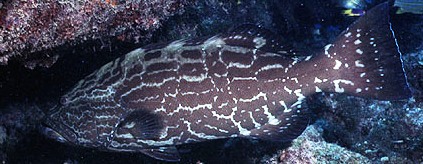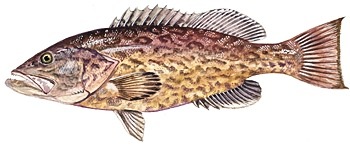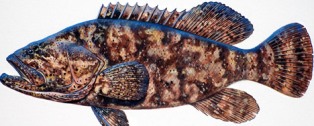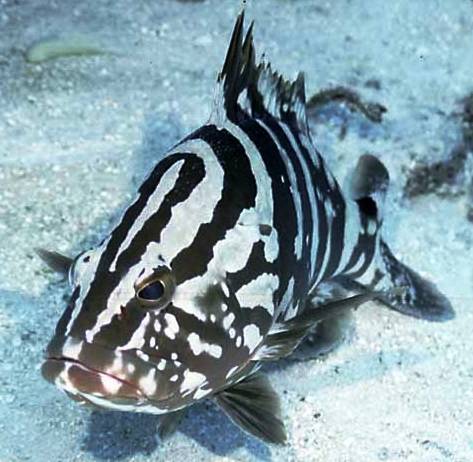Discover Florida Nature
It's time to explore the natural Florida


|
|
|
|
|
 Black
Grouper (Mycteroperca bonaci) The black grouper is
found throughout the western Atlantic Ocean. The northern boundary of
its range is off Massachusetts and extends east to Bermuda. The range
extends south to southern Brazil. It is also present in Gulf of Mexico
and the Caribbean Sea, including the Florida Keys and Cuba. Black
groupers are found mainly on rocky bottoms and in coral reef
environments. Their depth ranges from anywhere from 19 to 108 feet.
Juvenile black groupers are also found in seagrass beds off of the coast
of Florida. The black grouper is a large hearty fish with a protruding
lower jaw. It has an oblong body shape and rounded margins on both the
dorsal and anal fins. The caudal fin is squared-off, and the dorsal fin
has 11 spines and 15-17 rays. The preopercule is rounded without the
presence of a notch, which distinguishes it from the gag grouper. Black
groupers can reach up to 52 inches in length and can weigh up to 179
pounds. Most of the black grouper that are caught average a little over
2 feet in length. They can live over 30 years, but most of the growth
occurs during the first ten years of life. Adult black grouper feed
primarily on other smaller reef fishes, including grunts, snapper, and
herrings. They also feed on crustaceans. Juvenile black groupers feed
solely on crustaceans. Black grouper are protogynous hermaphrodites.
This means that all of the fish are born as females. Later in life, some
of the fish will change from male to female so the population can
reproduce. Black
Grouper (Mycteroperca bonaci) The black grouper is
found throughout the western Atlantic Ocean. The northern boundary of
its range is off Massachusetts and extends east to Bermuda. The range
extends south to southern Brazil. It is also present in Gulf of Mexico
and the Caribbean Sea, including the Florida Keys and Cuba. Black
groupers are found mainly on rocky bottoms and in coral reef
environments. Their depth ranges from anywhere from 19 to 108 feet.
Juvenile black groupers are also found in seagrass beds off of the coast
of Florida. The black grouper is a large hearty fish with a protruding
lower jaw. It has an oblong body shape and rounded margins on both the
dorsal and anal fins. The caudal fin is squared-off, and the dorsal fin
has 11 spines and 15-17 rays. The preopercule is rounded without the
presence of a notch, which distinguishes it from the gag grouper. Black
groupers can reach up to 52 inches in length and can weigh up to 179
pounds. Most of the black grouper that are caught average a little over
2 feet in length. They can live over 30 years, but most of the growth
occurs during the first ten years of life. Adult black grouper feed
primarily on other smaller reef fishes, including grunts, snapper, and
herrings. They also feed on crustaceans. Juvenile black groupers feed
solely on crustaceans. Black grouper are protogynous hermaphrodites.
This means that all of the fish are born as females. Later in life, some
of the fish will change from male to female so the population can
reproduce. Gag
(Mycteroperca microlepis) Gag grouper have long,
compressed bodies and 11 to 14 rays in the anal fins. Coloration is
highly variable in gag and changes with the size of the fish. Large gag
are dark brownish-gray above and paler below, with traces of dark wavy
markings on the sides. Smaller fish are much lighter and have numerous
dark brown or charcoal kiss-like marks along the sides. The Scamp and
black grouper closely resemble the gag and often occur in the same
habitat. Gag have deeply notched preopercles, distinguishing them from
black grouper. Gag may live for 26 years and grow to be 58 inches in
length and weigh up to 81 pounds. Gag often congregate around rocky
ledges and swim in small groups. They are predators of round scad,
sardines, porgies, snappers, grunts, crabs, shrimp and squid. The gag
grouper is the most widely distributed grouper in the region, with
adults present from North Carolina to Brazil over low- and high-profile
hard bottom in waters 60-500 feet deep. The species is found in the Gulf
of Mexico, but not in the West Indies. Young gag inhabit estuaries from
Massachusetts to Cape Canaveral. Spawning takes place in February off
the coast of the Carolinas and in January through March in the Gulf of
Mexico. Gag are protogynous hermaphrodites, which means they begin life
as female, however after a few years of spawning, some gag groupers
change sex, becoming males. Gag
(Mycteroperca microlepis) Gag grouper have long,
compressed bodies and 11 to 14 rays in the anal fins. Coloration is
highly variable in gag and changes with the size of the fish. Large gag
are dark brownish-gray above and paler below, with traces of dark wavy
markings on the sides. Smaller fish are much lighter and have numerous
dark brown or charcoal kiss-like marks along the sides. The Scamp and
black grouper closely resemble the gag and often occur in the same
habitat. Gag have deeply notched preopercles, distinguishing them from
black grouper. Gag may live for 26 years and grow to be 58 inches in
length and weigh up to 81 pounds. Gag often congregate around rocky
ledges and swim in small groups. They are predators of round scad,
sardines, porgies, snappers, grunts, crabs, shrimp and squid. The gag
grouper is the most widely distributed grouper in the region, with
adults present from North Carolina to Brazil over low- and high-profile
hard bottom in waters 60-500 feet deep. The species is found in the Gulf
of Mexico, but not in the West Indies. Young gag inhabit estuaries from
Massachusetts to Cape Canaveral. Spawning takes place in February off
the coast of the Carolinas and in January through March in the Gulf of
Mexico. Gag are protogynous hermaphrodites, which means they begin life
as female, however after a few years of spawning, some gag groupers
change sex, becoming males. Goliath
(itajara) The goliath grouper occurs in the western Atlantic
Ocean from Florida south to Brazil, including the Gulf of Mexico and the
Caribbean Sea. Occurring in shallow, inshore waters to depths of 150
feet, the goliath grouper prefers areas of rock, coral, and mud
bottoms. Strikingly patterned juveniles inhabit mangroves and brackish
estuaries, especially near oyster bars. The goliath grouper is notable
as one of the few groupers found in brackish waters. This fish is
solitary by nature, with the adults occupying limited home ranges. It is
territorial near areas of refuge such as caves, wrecks, and ledges,
displaying an open mouth and quivering body to intruders. Goliath
grouper are the largest members of the sea bass family in the Atlantic
Ocean. The body is robust and elongate; its widest point is more than
half its total length. The head is broad with small eyes. The dorsal
fins are continuous with the rays of the soft dorsal longer than the
spines of the first dorsal fin. The membranes between the dorsal fin
elements are notched. Pectoral fins are rounded and noticeably larger
than the pelvic fins. Bases of the soft dorsal and anal fins are covered
with scales and thick skin. The caudal fin is rounded. Goliath grouper
have three to five rows of teeth in the lower jaw. The presence of a
number of short weakly developed canine teeth is useful in
distinguishing this species from other North Atlantic groupers. The
goliath grouper is the largest grouper in the western Atlantic. Growing
to lengths of 8.2 feet, this grouper can weigh as much as 800 pounds.
In Florida, the largest hook and line captured specimen weighed 680
pounds! The oldest verifiable goliath grouper on record is 37 years.
However, this specimen was sampled from a population of individuals
depressed by fishing pressure and it is projected that goliath grouper
may live much longer, perhaps as much as 50 years. Goliath
(itajara) The goliath grouper occurs in the western Atlantic
Ocean from Florida south to Brazil, including the Gulf of Mexico and the
Caribbean Sea. Occurring in shallow, inshore waters to depths of 150
feet, the goliath grouper prefers areas of rock, coral, and mud
bottoms. Strikingly patterned juveniles inhabit mangroves and brackish
estuaries, especially near oyster bars. The goliath grouper is notable
as one of the few groupers found in brackish waters. This fish is
solitary by nature, with the adults occupying limited home ranges. It is
territorial near areas of refuge such as caves, wrecks, and ledges,
displaying an open mouth and quivering body to intruders. Goliath
grouper are the largest members of the sea bass family in the Atlantic
Ocean. The body is robust and elongate; its widest point is more than
half its total length. The head is broad with small eyes. The dorsal
fins are continuous with the rays of the soft dorsal longer than the
spines of the first dorsal fin. The membranes between the dorsal fin
elements are notched. Pectoral fins are rounded and noticeably larger
than the pelvic fins. Bases of the soft dorsal and anal fins are covered
with scales and thick skin. The caudal fin is rounded. Goliath grouper
have three to five rows of teeth in the lower jaw. The presence of a
number of short weakly developed canine teeth is useful in
distinguishing this species from other North Atlantic groupers. The
goliath grouper is the largest grouper in the western Atlantic. Growing
to lengths of 8.2 feet, this grouper can weigh as much as 800 pounds.
In Florida, the largest hook and line captured specimen weighed 680
pounds! The oldest verifiable goliath grouper on record is 37 years.
However, this specimen was sampled from a population of individuals
depressed by fishing pressure and it is projected that goliath grouper
may live much longer, perhaps as much as 50 years. Nassau
Grouper (striatus) The Nassau grouper is found
throughout the tropical western Atlantic Ocean, including Bermuda,
Florida, Bahamas, and throughout the Caribbean Sea, south to Brazil.
Occurs in the Gulf of Mexico in limited locations including the Yucatan,
Tortugas, and Key West. This grouper is common on offshore rocky bottoms
and coral reefs throughout the Caribbean region. They occur at a depth
range extending to at least 295 feet, preferring to rest near or close
to the bottom. Juveniles are found closer to shore in seagrass beds that
offer a suitable nursery habitat. The Nassau grouper is an oblong, large
fish with large eyes and coarse, spiny fins. The third or fourth spine
of the dorsal fin is longer than the second spine. Pelvic fins are
shorter than the pectoral fins, with the insertion point located below
or behind the ventral terminus of the pectoral fin base. The bases of
the soft dorsal and anal fins are covered with scales and skin. Caudal
fin is rounded in juveniles, convex in adults. Groupers have several
sets of strong, slender teeth that act as raspers. These teeth are not
used to tear flesh as with the barracudas and sharks, but rather to
prevent small fish from escaping. Growing to a maximum of 4 feet and
weighing over 50 pounds, this grouper is one of the largest fish on the
reef. More commonly, this grouper reaches a length of 1-2 feet and
weighs 10-20 pounds. The maximum age reported for this fish is 16 years.
As a carnivorous predator, the Nassau grouper has a diet that consists
mainly of fish, shrimps, crabs, lobsters, and octopuses. Prey fish
include parrotfishes, wrasses, damselfishes, squirrelfishes, snappers,
and grunts. This clever fish patiently waits in hiding, utilizing its
ability to camouflage, until it pounces on its prey. By opening its
mouth and dilating the gill covers to draw water in, groupers generally
engulf their prey hole in one quick motion. An interesting note, as a
friendly, unwary fish, if offered food by divers it will repeatedly
return searching for more food handouts. Nassau
Grouper (striatus) The Nassau grouper is found
throughout the tropical western Atlantic Ocean, including Bermuda,
Florida, Bahamas, and throughout the Caribbean Sea, south to Brazil.
Occurs in the Gulf of Mexico in limited locations including the Yucatan,
Tortugas, and Key West. This grouper is common on offshore rocky bottoms
and coral reefs throughout the Caribbean region. They occur at a depth
range extending to at least 295 feet, preferring to rest near or close
to the bottom. Juveniles are found closer to shore in seagrass beds that
offer a suitable nursery habitat. The Nassau grouper is an oblong, large
fish with large eyes and coarse, spiny fins. The third or fourth spine
of the dorsal fin is longer than the second spine. Pelvic fins are
shorter than the pectoral fins, with the insertion point located below
or behind the ventral terminus of the pectoral fin base. The bases of
the soft dorsal and anal fins are covered with scales and skin. Caudal
fin is rounded in juveniles, convex in adults. Groupers have several
sets of strong, slender teeth that act as raspers. These teeth are not
used to tear flesh as with the barracudas and sharks, but rather to
prevent small fish from escaping. Growing to a maximum of 4 feet and
weighing over 50 pounds, this grouper is one of the largest fish on the
reef. More commonly, this grouper reaches a length of 1-2 feet and
weighs 10-20 pounds. The maximum age reported for this fish is 16 years.
As a carnivorous predator, the Nassau grouper has a diet that consists
mainly of fish, shrimps, crabs, lobsters, and octopuses. Prey fish
include parrotfishes, wrasses, damselfishes, squirrelfishes, snappers,
and grunts. This clever fish patiently waits in hiding, utilizing its
ability to camouflage, until it pounces on its prey. By opening its
mouth and dilating the gill covers to draw water in, groupers generally
engulf their prey hole in one quick motion. An interesting note, as a
friendly, unwary fish, if offered food by divers it will repeatedly
return searching for more food handouts.
|
|
|
Advertise | Privacy Statement | Dog Encyclopedia | Video |Contact | Alaska Nature |
|